Related Research Articles
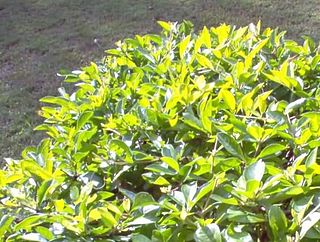
Pruning is a horticultural, arboricultural, and silvicultural practice involving the selective removal of certain parts of a plant, such as branches, buds, or roots.
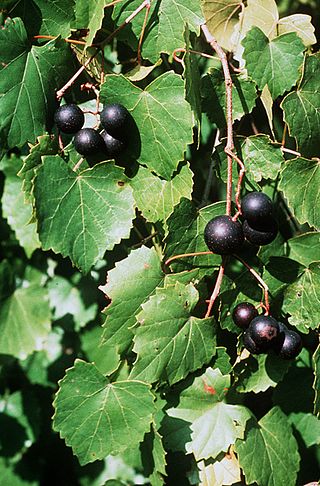
Vitis rotundifolia, or muscadine, is a grapevine species native to the southeastern and south-central United States. The growth range extends from Florida to New Jersey coast, and west to eastern Texas and Oklahoma. It has been extensively cultivated since the 16th century. The plants are well-adapted to their native warm and humid climate; they need fewer chilling hours than better known varieties, and thrive in summer heat.

Phomopsis cane and leaf spot occurs wherever grapes are grown. Phomopsis cane and leaf spot is more severe in grape-growing regions characterized by a humid temperate climate through the growing season. Crop losses up to 30% have been reported to be caused by Phomopsis cane and leaf spot.
Eutypa lata is a fungal plant pathogen of grapevines. The fungus also attacks many other hosts such as cherry trees, most other Prunus species, as well as apples, pears and walnuts. In apricots, the fungus reveals a canker surrounding a pruning wound.

Lasiodiplodia theobromae is a plant pathogen with a very wide host range. It causes rotting and dieback in most species it infects. It is a common post harvest fungus disease of citrus known as stem-end rot. It is a cause of bot canker of grapevine. It also infects Biancaea sappan, a species of flowering tree also known as Sappanwood.

Plasmopara viticola, the causal agent of grapevine downy mildew, is a heterothallic oomycete that overwinters as oospores in leaf litter and soil. In the spring, oospores germinate to produce macrosporangia, which under wet condition release zoospores. Zoospores are splashed by rain into the canopy, where they swim to and infect through stomata. After 7–10 days, yellow lesions appear on foliage. During favorable weather the lesions sporulate and new secondary infections occur.
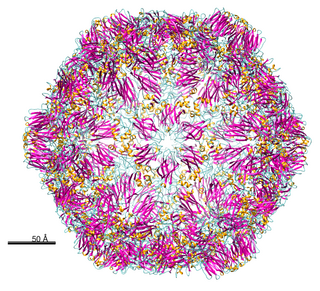
Grapevine fanleaf virus (GFLV) is a plant pathogenic virus of the family Secoviridae. It infects grapevines, causing chlorosis of the leaves and lowering the fruit quality. Because of its effect on grape yield, GFLV is a pathogen of commercial importance. It is transmitted via a nematode vector, Xiphinema index. This nematode acquires the virus through feeding on roots of an infected plant, and passes it on in the same manner.
The fungal genus Truncatella in the family Sporocadaceae, and in the Amphisphaeriales order, includes plant pathogens such as Truncatella laurocerasi.

Flavescence dorée is one of the most important and damaging phytoplasma diseases of the vine with the potential to threaten vineyards. The bacterial agent has recently been named Candidatus Phytoplasma vitis, and its vector is the leafhopper, Scaphoideus titanus. Infection may kill young vines and greatly reduce the productivity of old vines. It is classified as a phytoplasma disease belonging to the group generically termed grapevine yellows. Occurrences are in sporadic epidemics, and varieties vary in their sensitivity to it.

In viticulture, the canopy of a grapevine includes the parts of the vine visible aboveground - the trunk, cordon, stems, leaves, flowers, and fruit. The canopy plays a key role in light energy capture via photosynthesis, water use as regulated by transpiration, and microclimate of ripening grapes. Canopy management is an important aspect of viticulture due to its effect on grape yields, quality, vigor, and the prevention of grape diseases. Various viticulture problems, such as uneven grape ripening, sunburn, and frost damage, can be addressed by skillful canopy management. In addition to pruning and leaf trim, the canopy is often trained on trellis systems to guide its growth and assist in access for ongoing management and harvest.
This glossary of viticultural terms list some of terms and definitions involved in growing grapes for use in winemaking.

The use of vine training systems in viticulture is aimed primarily to assist in canopy management with finding the balance in enough foliage to facilitate photosynthesis without excessive shading that could impede grape ripening or promote grape diseases. Additional benefits of utilizing particular training systems could be to control potential yields and to facilitate mechanization of certain vineyard tasks such as pruning, irrigation, applying pesticide or fertilizing sprays as well as harvesting the grapes.
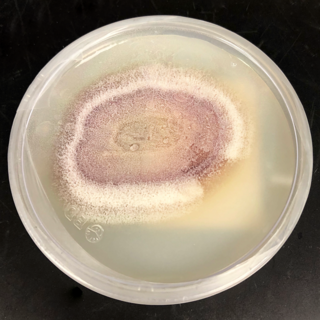
Phaeoacremonium is a fungus genus associated with wilt and decline diseases of woody hosts and human infections.
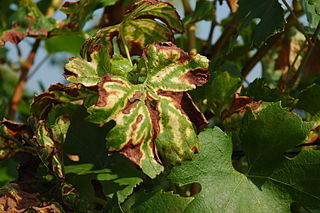
Esca is a grape disease of mature grapevines. It is a type of grapevine trunk disease.

The propagation of grapevines is an important consideration in commercial viticulture and winemaking. Grapevines, most of which belong to the Vitis vinifera family, produce one crop of fruit each growing season with a limited life span for individual vines. While some centenarian old vine examples of grape varieties exist, most grapevines are between the ages of 10 and 30 years. As vineyard owners seek to replant their vines, a number of techniques are available which may include planting a new cutting that has been selected by either clonal or mass (massal) selection. Vines can also be propagated by grafting a new plant vine upon existing rootstock or by layering one of the canes of an existing vine into the ground next to the vine and severing the connection when the new vine develops its own root system.
Phaeomoniella chlamydospora is a fungus species of mitosporic ascomycota in the genus Phaeomoniella.
Grapevine trunk diseases (GTD) are the most destructive diseases of vineyards worldwide. Fungicides with the potential to control GTD have been banned in Europe and there are no highly effective treatments available. Action to develop new strategies to fight these diseases are needed.
Trunk injection or endotherapy also known as vegetative endotherapy, is a method of target-precise application of pesticides, plant resistance activators, or fertilizers into the xylem vascular tissue of a tree with the purpose of protecting the tree from pests, or to inject nutrients to correct for nutrient deficiencies. This method largely relies on harnessing the tree's vascular system to translocate and distribute the active compounds into the wood, canopy and roots where protection or nutrition is needed.

Sporocadus is a genus of plant pathogens in the family Sporocadaceae.
References
- ↑ Occurrence of grapevine trunk disease pathogens in rootstock mother plants in South Africa. P. H. Fourie and F. Halleen, Australasian Plant Pathology, June 2004, Volume 33, Issue 2, pages 313-315, doi : 10.1071/AP04005